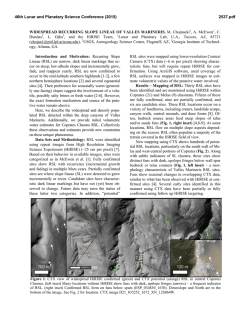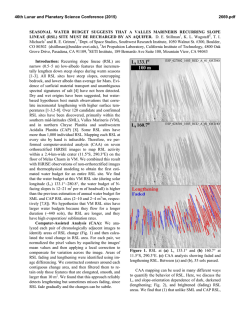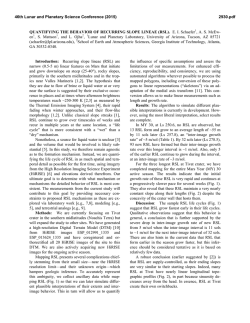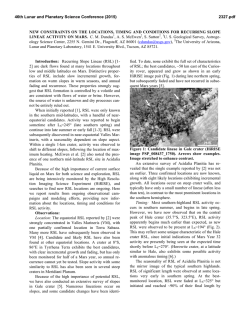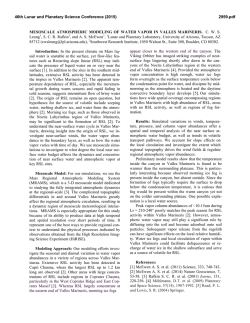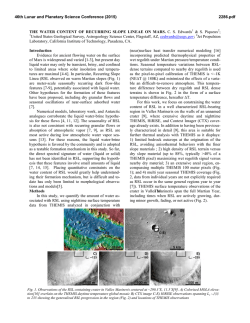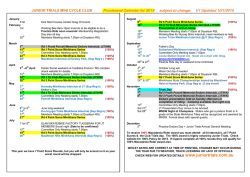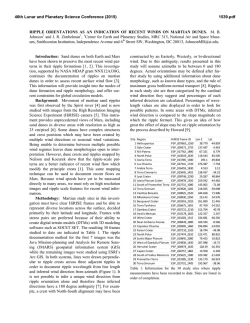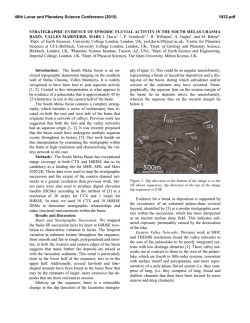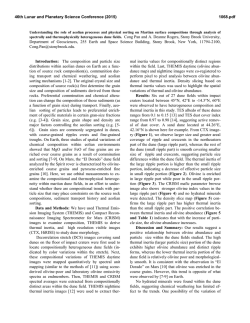
ACTIVE SLOPES OF VALLES MARINERIS – WIND, WATER, AND
46th Lunar and Planetary Science Conference (2015) 2752.pdf ACTIVE SLOPES OF VALLES MARINERIS – WIND, WATER, AND GRAVITY. M. Chojnacki1, A. McEwen1, C. Dundas2, S. Sutton1, L. Ojha3, S. Byrne1, and the HiRISE Team, 1Lunar and Planetary Lab, U.A., Tucson, AZ, 85721 ([email protected]), 2USGS, Astrogeology Science Center, Flagstaff, AZ, 3Georgia Institute of Technology, Atlanta, GA. Introduction and Motivation: Recurring Slope Lineae (RSL) are dark streaks with a seasonal activity that suggests their formation is controlled by a volatile [1-2]. Note, the involvement of a volatile is hereafter assumed. The steep slopes of Valles Marineris (VM), in addition to having the most densely populated RSL areas yet detected [3-5], also show evidence for contemporary aeolian activity and mass wasting. How these different types of processes might overlap has not been thoroughly discussed. Here, we will focus on how RSL interact with different surface classes. In addition to RSL which occur on talus and sandy fan surfaces [3], monitoring has also revealed seasonal dune Slope Lineae (SL) that appear to fit the criteria for RSL (i.e., growth, fading, and annual occurrence) [1]. Driving questions include: what are the morphological and physical characteristics of RSL surfaces? How do these surfaces evolve? Data Sets and Methods: To assess RSL activity, we used repeat images from High Resolution Imaging Science Experiment (HiRISE) [6]. In addition, we constructed several Digital Terrain Models (DTMs) (at 1 m post spacing) from HiRISE stereo pairs [7] for topographic analysis. Overlapping orthorectified images were used to characterize the temporal behavior of RSL. Additionally, thermal inertia was derived from THEMIS data [8] to assess the thermophysical properties of RSL surfaces, following methods described in [9]. Results – RSL Surfaces: RSL in VM are most frequently detected on the low albedo (<0.14), steep slopes of the spur-and-gully wall units [4]. Bedrock spurs and ridges, presumed to be fluid sources, appear to feed the slopes below, which are composed of talus, sandy fans, and/or dark duneforms. Talus RSL: RSL superposed on mid-toned talus surfaces frequently form long widely separated flows, including the longest continuous RSL detected to date. Similar to mid-latitudes RSL [2], branching or sinuous patterns of lineae can occur. Flows typically follow shallow gullies within the talus. In a few cases, the development of small new gullies following RSL flows [10] supports the notion that RSL play a role in topographically modifying the local surface. Talus surfaces possess model thermal inertias of 350-650 Jm–2K–1s–1/2 (e.g., coarse sand, boulders, unconsolidated bedrock). Fan RSL: RSL within VM are most frequently detected on low to moderate albedo fans of sandy sheets (Fig. 1). Straight and narrows RSL repeatedly occur in shallow (5–10 m) “tracks” (resolvable in a HiRISE DTM) situated below ripples (see below), likely carved by the lineae. RSL fans also show seasonal changes in HiRISE enhanced-color [3] and broadband CTX albedo [5]. Fan surfaces have thermal inertias of 250-400 Jm– 2 –1 –1/2 K s (e.g., sand, pebbles, cobbles). Duneform RSL: Many low albedo duneforms have distinctive dark SL, primarily on slip faces (Fig. 2). Dune SL are frequently active (i.e., growth and reoccurrence) when nearby wall RSL are forming, although it is often unclear whether growth of lineae is occurring or old lineae are simply overprinted by aeoliantriggered slip face avalanches. Shadowing and low Figure 1. HiRISE color views of fan surfaces with RSL (white arrows), truncated ripples (upper inset), and lower slope ripples (lower inset), all below talus (black arrows). Downslope is toward the bottom in all images. 46th Lunar and Planetary Science Conference (2015) Figure 2. HiRISE color view of a Coprates Chasma dune slip face with possible RSL (arrows). signal-to-noise ratios make monitoring difficult. Thermal inertias of dune slopes are modeled at 220-350 Jm– 2 –1 –1/2 K s (e.g., medium to coarse grained sand). Aeolian Activity: At most sites with RSL fans, patchy groups of truncated ripples form on fans perpendicular to the slope with a groove spacing of a few meters (4– 10 m) (Fig. 1, upper inset). These ripples transition into small fields of aeolian ripples of a similar wavelength (Fig. 1, lower inset). Many upper fan ripples are moving downslope at rates of several meters per Mars year and when adjacent RSL are active. Mass Movement: Evidence for mass-wasting is ubiquitous across VM RSL sites. Boulder tracks, boulders, and larger lobes of talus commonly appear on steep slopes at or near the static angle of response (30°–40°) for many expected sediment sizes. Where boulders and their tracks are found superposed on aeolian surfaces, these events indicate mass-wasting has occurred after bulk bedform construction, likely geologically young [11]. One Melas Chasma crater with RSL active for the majority of the year hosts the largest confirmed topographic change with a large (20 m by 250 m), initially dark slump [12]. Although RSL are nearby and likely contributed to triggering the event, gravity clearly had a role in forming the slump. Slumps of a similar scale and morphology are common at many VM RSL sites, driven by gravity and possibly initiated by fluid flow. Discussion – Duneform RSL? Although an aeolian origin for SL forming on dune slip faces would be the simplest explanation for the phenomena, a few of these occurrences fit the definition of confirmed RSL. Dune slip faces with SL are not advancing at expected rates (a few meters per Mars year) [9,13] – although topography can retard dunes movement. In addition to their frequent spatial correlation, both dune and fan surfaces have similar thermophysical properties. In some cases, fans merge into duneforms (Fig. 3) confirming both are made of sand-sized material. In contrast, SL on migrating dunes far from known RSL sites are often lighter in tone than surrounding sand [13]. Additionally, thermal models predict favorable (day- 2752.pdf time) seasonal temperatures (>273 K) for RSL occurrence on most dune/fans slope aspects throughout the year. If confirmed, RSL which occur on freestanding dunes effectively eliminate many fluid source mechanisms (e.g., ice, regional groundwater, deep brines) and may point to an atmospheric phenomenon. However, modeling, experimental work, and extended monitoring will be required to support this hypothesis. Landscape evolution: It is now known that Coprates and Melas host the densest population yet detected of both RSL [5] and the morphological dune class of climbing and falling dunes [9,14]. Many of these occurrences are co-located (see 5, Fig. 2), where dunes are immediately downslope from, or overlapping with, RSL fans. The local sourcing of these “wall dunes” has been supported based on multiple lines of evidence [11]. Based on these observations, we propose a model where RSL fluids and gravity conspire to erode and transport fine sand-sized material downslope to progressively form dark fans. Katabatic canyon winds [9] also play a role where they move ripples downslope and slowly modify the surface. Eventually, duneforms develop, migrate, and become modified by RSL. While large-scale landslides may be infrequent, smaller topography-modifying slope events detectable in HiRISE (e.g., [10,12]) probably occur every few Mars years. Future monitoring and analysis will test this model. Acknowledgements: Funding for this work came in part from NASA MDAP grant NNX13AK01G. References: [1] McEwen A. et al. (2011) Science, 333, 740–743. [2] Ojha L. et al. (2014) Icarus, 231, 365–376. [3] McEwen A. et al. (2014a) Nat. Geo., 7, 53–58. [4] Chojnacki M. et al. (2014a) LPSC XLV, abstract 2701. [5] Chojnacki M. et al. (2015) This Conference. [6] McEwen A. et al. (2007) JGR, 112, E05S02. [7] Kirk R. et al. (2008) JGR, 113, E00A24. [8] Christensen P. et al. (2004) Space Sci. Rev., 110, 85–130. [9] Chojnacki M. et al. (2014b) Icarus, 230, 96– 142. [10] Chojnacki M. et al. (2014c) 8th Inte. Conf. Mars, abstract 1417. [11] Chojnacki M. et al. (2014c) Icarus, 232, 187–219. [12] McEwen A. et al. (2014b) 8th Inte. Conf. Mars, abstract 1147. [13] Bridges N. et al. (2012) Geology, 40, 31–34. [14] Chojnacki M. et al. (2010) GRL, 37, L08201. Figure 3. RSL (white arrows) forming below talus (black arrows) in south Melas Chasma, where RSL fans merge into small duneforms.
© Copyright 2024
